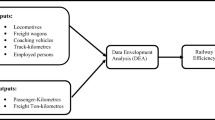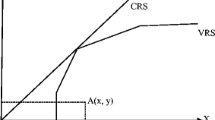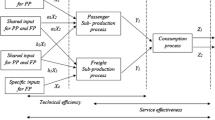Abstract
This paper attempts to measure the performance of railway companies that produce passenger and freight services around the world. The data covering 10 years from 2000 to 2009 is analyzed first via the data envelopment analysis method in order to obtain technical efficiency and allocative efficiency scores of 31 railway companies for the purpose of the study. In the analysis conducted by use of the CCR model, while total 17 firms were efficient in the first year, this figure reaches to 18 companies for the last year with one more addition. While only two companies seem efficient in the first year, this figure goes down to one for the last year. With input oriented and variable return analysis conducted by use of the BCC model, the firms having technical efficiency at the beginning of the period were 20 in number. At the end of the period, the figure reaches to 24. Next, the outputs of DEA are correlated by Tobit regression and tried to determine decisiveness of the outputs on the efficiency. It has been seen that the same output composition used with Tobit analysis gives more compliant results with the allocative efficiency scores rather than with the technical efficiency scores.
Similar content being viewed by others
References
Atkinson S.E., Cornwell C.: Estimating radial measures of productivity growth: frontier vs non-frontier approaches. J. Product. Anal. 10, 35–46 (1998)
Banker R.D., Charnes A., Cooper W.W.: Some models for estimating technical and scale inefficiency in DEA. Manag. Sci. 30, 1078–1092 (1984)
Cantos P., Pastor J.M., Serrano L.: Productivity, efficiency and technical change in the European railways: a non-parametric approach. Transportation 26(4), 337–357 (1999)
Charnes A., Cooper W.W., Rhodes E.: Measuring the efficiency of decision making units. Eur. J. Oper. Res. 2, 429–444 (1978)
Charnes A., Cooper W.W., Rhodes E.: Short communication: measuring the efficiency of decision making units. Eur. J. Oper. Res. 3, 339 (1979)
Coelli T.A., Perelman S.: A comparison of parametric and non-parametric distance functions: with application to European railways. Eur. J. Oper. Res. 117, 326–339 (1999)
Cooper, W.W., Seiford, L.M., Tone, K.: Introduction to Data Envelopment Analysis and its Uses. Springer, New York (2006)
Cowie J.: The technical efficiency of public and private ownership in the rail industry: the case of swiss. J. Transp. Econ. Policy 33(3), 241–251 (1999)
Çekerol G.S., Nalçakan M.: Lojistik Sektörü Içerisinde Türkiye Demiryolu. Yurtiçi Yük Taşıma Talebinin Ridge Regresyonla Analizi. Marmara Üniversitesi I. I.B.F. Dergisi 31(2), 321–344 (2011)
Debreu G.: The coefficient of resource utilization. Econometrica 19(3), 273–292 (1951)
Duman, I.: Demiryollarının Yeniden Yapılanma Ihtiyacı ve TCDD’deki Gelişmeler. In: Proceedings, Uluslararası Demiryolu Sempozyumu, (2). Ankara (2006)
Evren G., Vitoşoğlu Y.: Türkiye’de Demiryolu Ağırlıklı Kombine Yük Taşımacılı ğı Olanaklarının Araştırılması. ITÜ Dergisi Seria D 7(1), 77–88 (2008)
Farrell M.J.: The measurement of productive efficiency. J. R. Stat. Soc. 120(3), 253–281 (1957)
Graham D.J.: Productivity and efficiency in urban railways: parametric and non-parametric estimates. Transp. Res. E 44(1), 84–99 (2008)
Greene, W.H.: Econometric analysis, 3rd edn. Prentice Hall, New Jersey (1997)
Jitsuzumi T., Nakamura A.: Socio-economic causes of inefficiency in japanese railways: application of DEA for managers and policymakers. Plan. Sci. 44, 161–173 (2010)
Kim H., Choi C., Woo J., Choi Y., Kim K., Wu D.: Efficiency of the modal shift and environmental policy on the Korean railroad. Stoch. Environ. Res. Risk Assess. 25(3), 91–97 (2011)
Koopmans, T.C.: An analysis of production as an efficient combination of activities. In: Koopmans, T.C. (ed.) Activity Analysis of Production and Allocation. Wiley, New Jersey (1951)
Kumbhakar, S.C., Lovell, C.A.K.: Stochastic Frontier Analysis. Cambridge University Press, Cambridge (2000)
Lan L.W., Lin E.T.J.: Performance measurement for railway transport: stochastic distance functions with inefficiency and ineffectiveness effects. J. Transp. Econ. Policy 40(3), 383–408 (2006)
Loizides J., Tsionas E.G.: Dynamic distributions of productivity growth in European railways. J. Transp. Econ. Policy 38(1), 45–76 (2004)
Merkert R., Hensher D.A.: The impact of strategic management and fleet planning on airline efficiency: a random effects tobit model based on dea efficiency scores. Transp. Res. 45/A, 686–695 (2011)
Nashand A.S.J., Nash C.A.: Benchmarking of train operating firms: a transaction cost efficiency analysis. Transp. Plan. Technol. 33(1), 35–53 (2010)
Sabri, K., Colson, G.E., Mbangala, A.M.: Multiple criteria and multiple periods performance analysis: the comparison of North African railways. In: AIP Conference Proceedings, Computing Anticipatory Systems: CASYS’07-Eighth International Conference, vol. 1051, pp.351–365. Melville (2008)
Scheraga C.A.: Operational efficiency versus financial mobility in the global airline industry: a data envelopment and tobit analysis. Transp. Res. 38/A, 383–404 (2004)
Şaşamaz, Ç.: Karyollarında ve Demiryollarında Verimlilik Analizi. Unpublished Dissertation, Pamukkale University, Fen Bilimleri Enstitüsü (2008)
TCDD, (Turkish Republic State Railways). Türkiye Cumhuriyeti Devlet Demiryolları Istatistik Yıllı ğı 2006–2010. http://www.tcdd.gov.tr/Upload/Files/ContentFiles/2010/istatistik/20062010yillik.pdf (2011). Accessed 1 Feb 2012
Tobin J.: Estimation of relationship for limited dependent variables. Econometrica 26(1), 24–36 (1958)
UIC (International Union of Railways). Railway Time-Series Data 1970–2009. http://www.uic.org/etf/publication/publication-detail.php?code_pub=302/70-09xl (2010). Accessed 1 Feb 2012
Wang S., Liao C.: Cost structure and productivity growth of the Taiwan railway. Transp. Res. E 42, 317–339 (2006)
Yu M.: Assessing the technical efficiency, service effectiveness, and technical effectiveness of the world’s railways through NDEA analysis. Transp. Res. A 42, 1283–1294 (2008)
Author information
Authors and Affiliations
Corresponding author
Rights and permissions
About this article
Cite this article
Kutlar, A., Kabasakal, A. & Sarikaya, M. Determination of the efficiency of the world railway companies by method of DEA and comparison of their efficiency by Tobit analysis. Qual Quant 47, 3575–3602 (2013). https://doi.org/10.1007/s11135-012-9741-0
Published:
Issue Date:
DOI: https://doi.org/10.1007/s11135-012-9741-0




